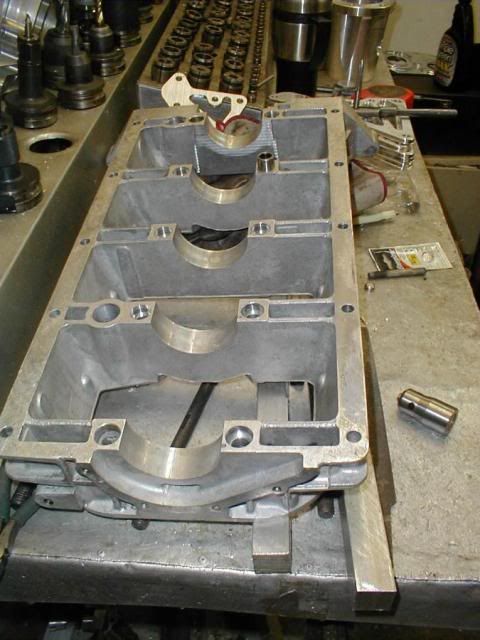Hi there,
I'm planning a high-performance rebuild of a Lotus 907 engine, which is an all-aluminum (except for cylinder liners) 2.0L (stock) 4-cylinder, DOHC, 16-valve, dating to the early '70's. It was used in the Jensen Healey originally; once the remaining development issues were ironed out this engine was used in the Lotus Esprit, Elite, and Eclat. Later, due to the issue I'm trying to resolve, the bottom end was redesigned and the engine was designated the 912.
The block is made up of three pieces, the block-proper, a lower panel that incorporates the main bearing caps, and the sump (which itself has structural significance).
The 907 is very oversquare and consequently has a high rpm torque peak, which makes daily driving, especially in traffic, a bit challenging. One way to deal with this is to increase stroke by fitting a crank from a 2.2L (with associated piston change). This is a drop-in, except that by all accounts the bottom end is not rigid enough to support extended enthusiastic driving (say, track day) for any length of time. Bearing failure is the typical result. (This is why Lotus eventually redesigned the bottom end.)
Experienced 907 builders typically recommend that the way to make the 907 live with a 2.2L crank is to add locating dowels between the block and the bearing panel. From the factory, only two dowels are fitted, one each at the No. 1 and No. 5 bearings. Builders recommend that eight more be added, so that each main bearing has two dowels locating the bearing panel to the block. (The dowels are hollow, 15mm I believe, and fit around each main bearing stud.)
What I'm wondering is if maybe there is a better/more modern way to attack this problem, with adhesive. In other words, use adhesive on the bearing cradle-to-block join rather than additional dowels. (Anaerobic sealer is already used at the outer flange for oil-tighness, but not typically along the bearing lines.)
The reason I'm thinking along these lines is that what was originally spec'd to be a cork-gasketed join between the sump and bearing panel is now advised to be essentially metal-metal, sealed just with Hylomar. (In fact, some builders advise that the added rigidity gained by eliminating the sump gasket is enough to solve the flexibility issue, although I would like added piece of mind...) Also, this engine is pretty buzzy at high RPMs, and intuitively adhesive would make the structure more "of one piece".
If this doesn't seem like a completely FUBAR idea, can someone recommend a suitable adhesive? (I haven't been able to determine what type of aluminum is is...)
Thanks for any advice, encouraging or discouraging the idea...
I'm planning a high-performance rebuild of a Lotus 907 engine, which is an all-aluminum (except for cylinder liners) 2.0L (stock) 4-cylinder, DOHC, 16-valve, dating to the early '70's. It was used in the Jensen Healey originally; once the remaining development issues were ironed out this engine was used in the Lotus Esprit, Elite, and Eclat. Later, due to the issue I'm trying to resolve, the bottom end was redesigned and the engine was designated the 912.
The block is made up of three pieces, the block-proper, a lower panel that incorporates the main bearing caps, and the sump (which itself has structural significance).
The 907 is very oversquare and consequently has a high rpm torque peak, which makes daily driving, especially in traffic, a bit challenging. One way to deal with this is to increase stroke by fitting a crank from a 2.2L (with associated piston change). This is a drop-in, except that by all accounts the bottom end is not rigid enough to support extended enthusiastic driving (say, track day) for any length of time. Bearing failure is the typical result. (This is why Lotus eventually redesigned the bottom end.)
Experienced 907 builders typically recommend that the way to make the 907 live with a 2.2L crank is to add locating dowels between the block and the bearing panel. From the factory, only two dowels are fitted, one each at the No. 1 and No. 5 bearings. Builders recommend that eight more be added, so that each main bearing has two dowels locating the bearing panel to the block. (The dowels are hollow, 15mm I believe, and fit around each main bearing stud.)
What I'm wondering is if maybe there is a better/more modern way to attack this problem, with adhesive. In other words, use adhesive on the bearing cradle-to-block join rather than additional dowels. (Anaerobic sealer is already used at the outer flange for oil-tighness, but not typically along the bearing lines.)
The reason I'm thinking along these lines is that what was originally spec'd to be a cork-gasketed join between the sump and bearing panel is now advised to be essentially metal-metal, sealed just with Hylomar. (In fact, some builders advise that the added rigidity gained by eliminating the sump gasket is enough to solve the flexibility issue, although I would like added piece of mind...) Also, this engine is pretty buzzy at high RPMs, and intuitively adhesive would make the structure more "of one piece".
If this doesn't seem like a completely FUBAR idea, can someone recommend a suitable adhesive? (I haven't been able to determine what type of aluminum is is...)
Thanks for any advice, encouraging or discouraging the idea...






